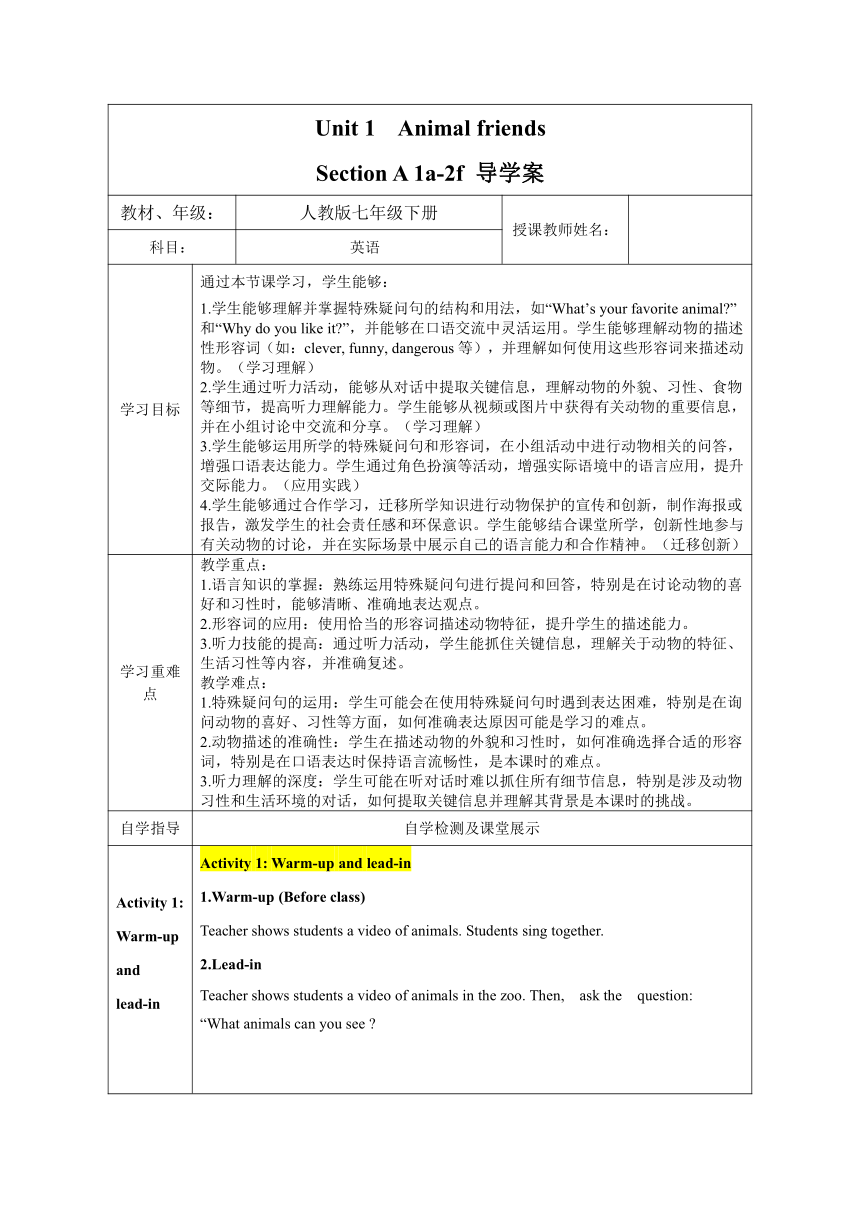
Unit 1 Animal friends Section A 1a-2f 导学案 教材、年级: 人教版七年级下册 授课教师姓名: 科目: 英语 学习目标 通过本节课学习,学生能够: 1.学生能够理解并掌握特殊疑问句的结构和用法,如“What’s your favorite animal ” 和“Why do you like it ”,并能够在口语交流中灵活运用。学生能够理解动物的描述性形容词(如:clever, funny, dangerous等),并理解如何使用这些形容词来描述动物。(学习理解) 2.学生通过听力活动,能够从对话中提取关键信息,理解动物的外貌、习性、食物等细节,提高听力理解能力。学生能够从视频或图片中获得有关动物的重要信息,并在小组讨论中交流和分享。(学习理解) 3.学生能够运用所学的特殊疑问句和形容词,在小组活动中进行动物相关的问答,增强口语表达能力。学生通过角色扮演等活动,增强实际语境中的语言应用,提升交际能力。(应用实践) 4.学生能够通过合作学习,迁移所学知识进行动物保护的宣传和创新,制作海报或报告,激发学生的社会责任感和环保意识。学生能够结合课堂所学,创新性地参与有关动物的讨论,并在实际场景中展示自己的语言能力和合作精神。(迁移创新) 学习重难点 教学重点: 1.语言知识的掌握:熟练运用特殊疑问句进行提问和回答,特别是在讨论动物的喜好和习性时,能够清晰、准确地表达观点。 2.形容词的应用:使用恰当的形容词描述动物特征,提升学生的描述能力。 3.听力技能的提高:通过听力活动,学生能抓住关键信息,理解关于动物的特征、生活习性等内容,并准确复述。 教学难点: 1.特殊疑问句的运用:学生可能会在使用特殊疑问句时遇到表达困难,特别是在询问动物的喜好、习性等方面,如何准确表达原因可能是学习的难点。 2.动物描述的准确性:学生在描述动物的外貌和习性时,如何准确选择合适的形容词,特别是在口语表达时保持语言流畅性,是本课时的难点。 3.听力理解的深度:学生可能在听对话时难以抓住所有细节信息,特别是涉及动物习性和生活环境的对话,如何提取关键信息并理解其背景是本课时的挑战。 自学指导 自学检测及课堂展示 Activity 1: Warm-up and lead-in Activity 1: Warm-up and lead-in 1.Warm-up (Before class) Teacher shows students a video of animals. Students sing together. 2.Lead-in Teacher shows students a video of animals in the zoo. Then, ask the question: “What animals can you see Activity 2: Pre- listening Activity 2: Pre-listening 1.Learn new words. The teacher prepares animal sounds and pictures . The teacher introduces the activity: "We are going to play a guessing game. First, I’ll play an animal’s sound and show its picture. Please guess which animal it is." 2.Let’s chant. 3.1a. Write the animals in the box under the pictures. Activity 3: While- listening Activity 3: While-listening 1b. Watch a video of an AI teacher and follow her to visit the zoo. Listen to the teacher’s instructions. Answer the questions. Tip1:Predict the answers before listening according to circling the wh-words. 2.1c. Listen and circle T for true or F for false. Tip2:听前先熟悉句子,预测听力内容。听的过程中,重点抓听与各个题干相关的信息,判断所听内容是否与题干相符,并圈出对应的答案. 3.Enjoy the video and find the differences. Listen, repeat and find out how to talk about animals. Read and Circle all the adjectives. Tip3:We can use adjs to describe animals. Activity 4: Post- listening Activity 4: Post-listening 1 ... ...
~~ 您好,已阅读到文档的结尾了 ~~